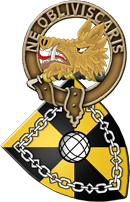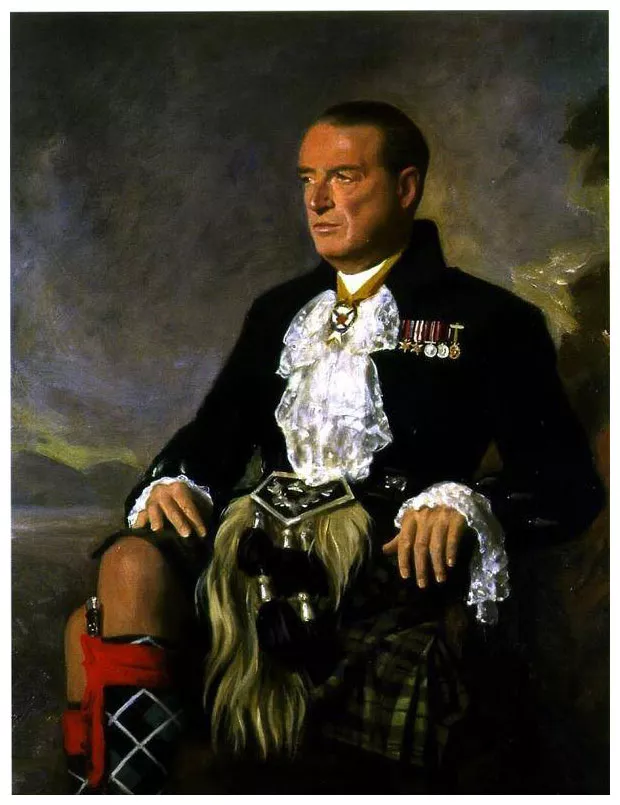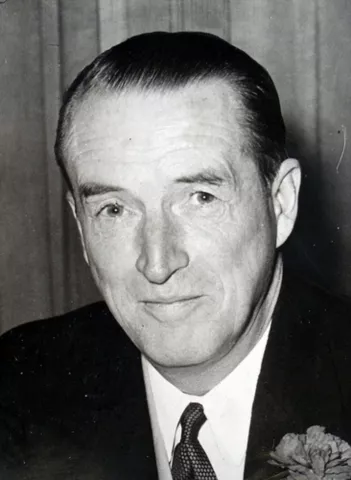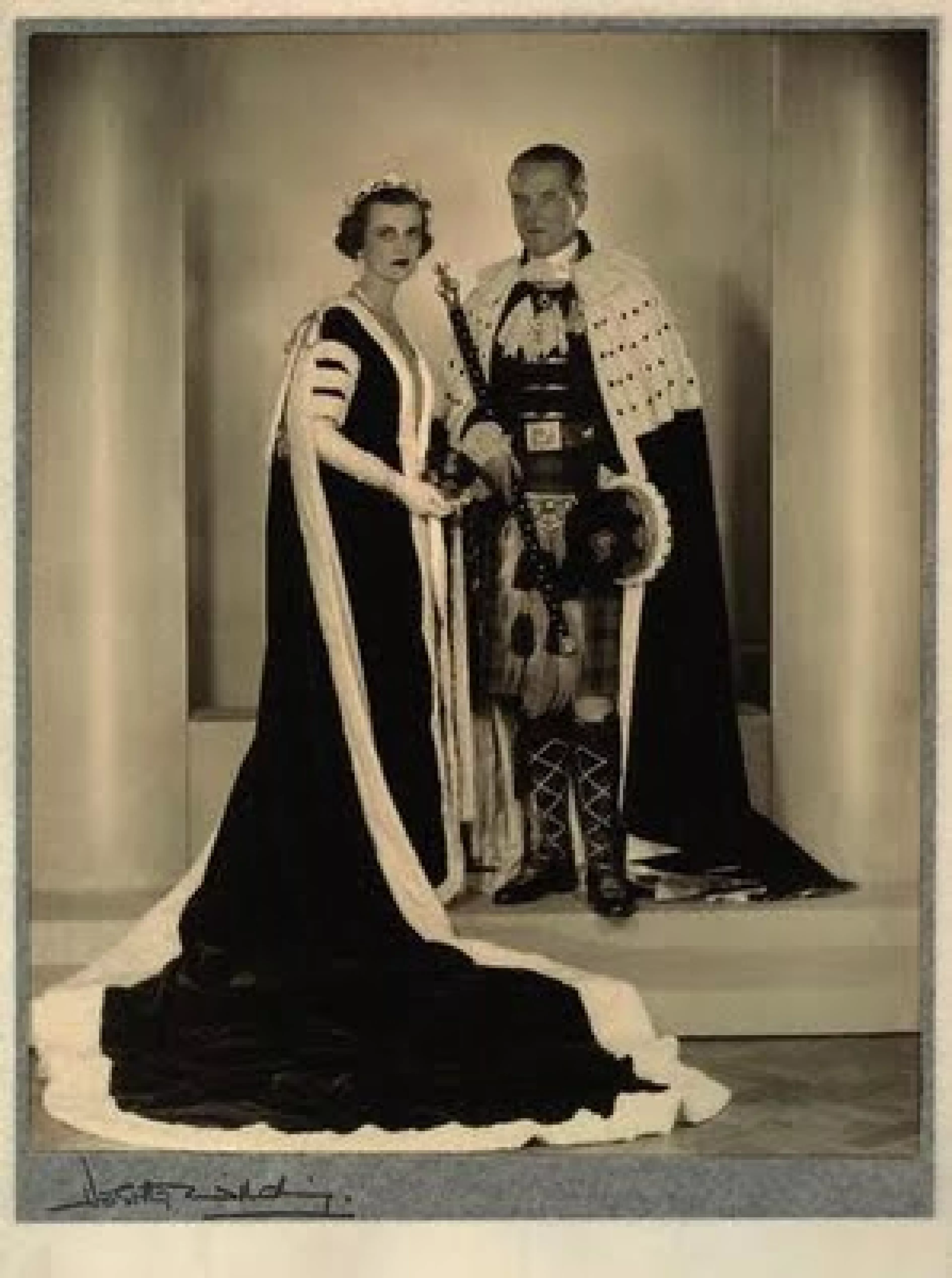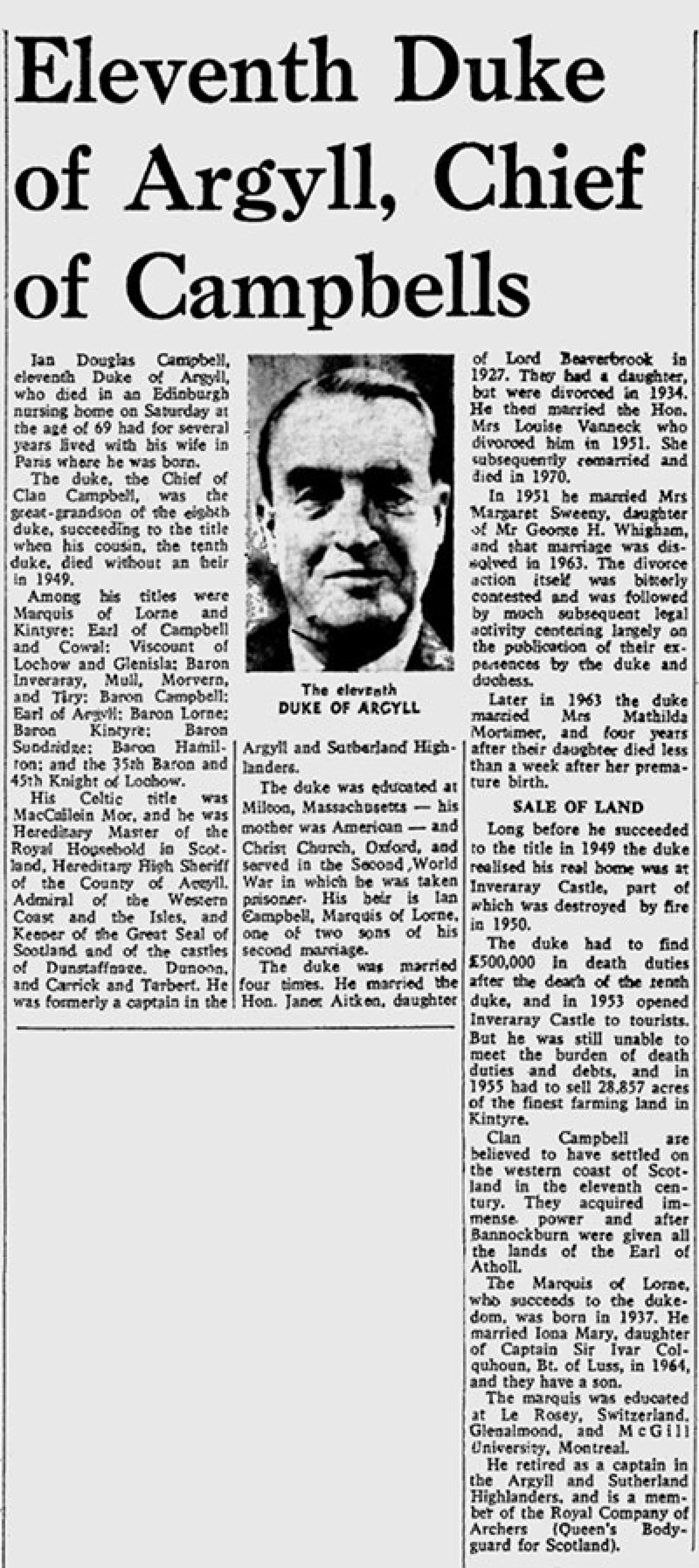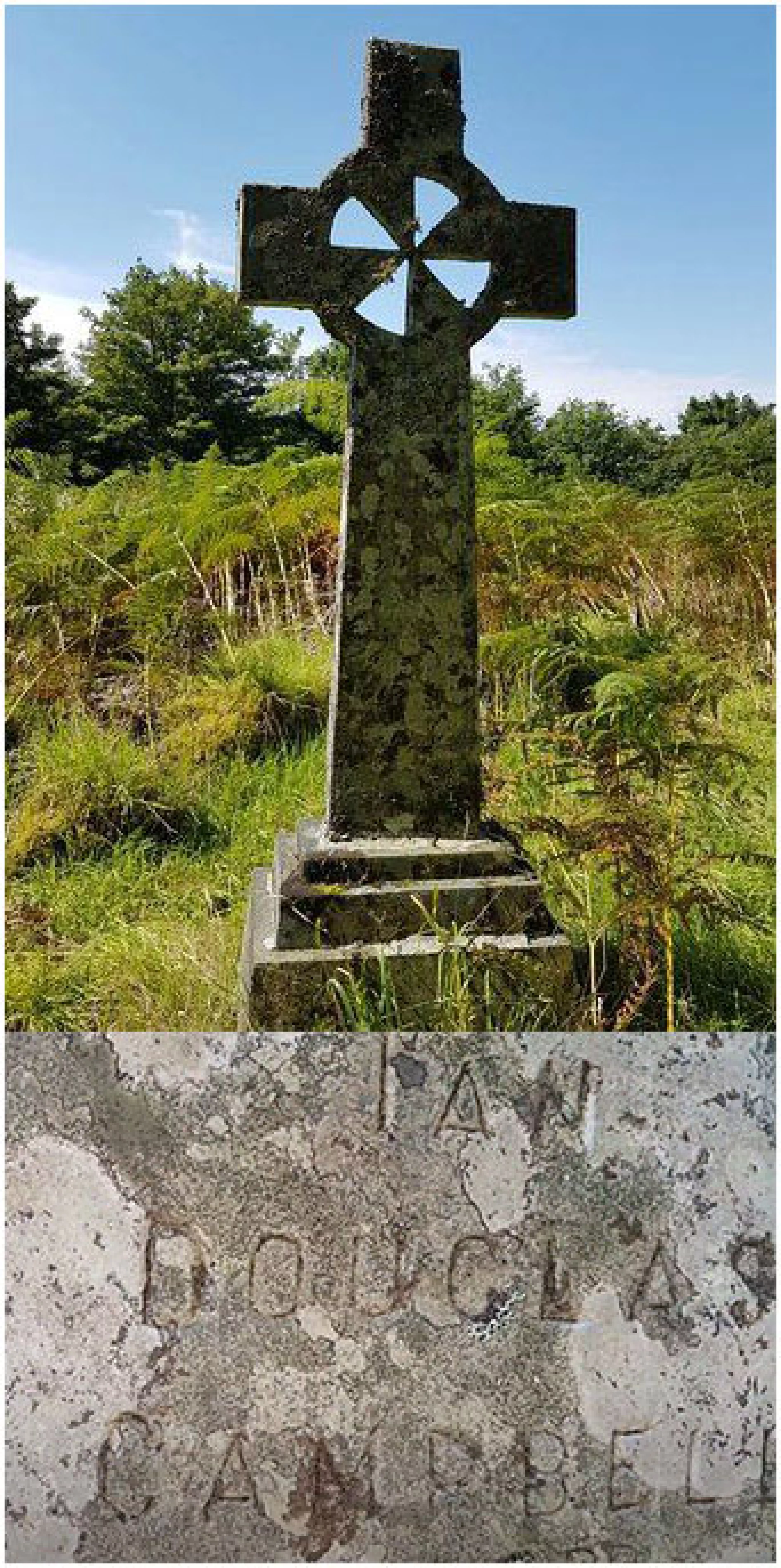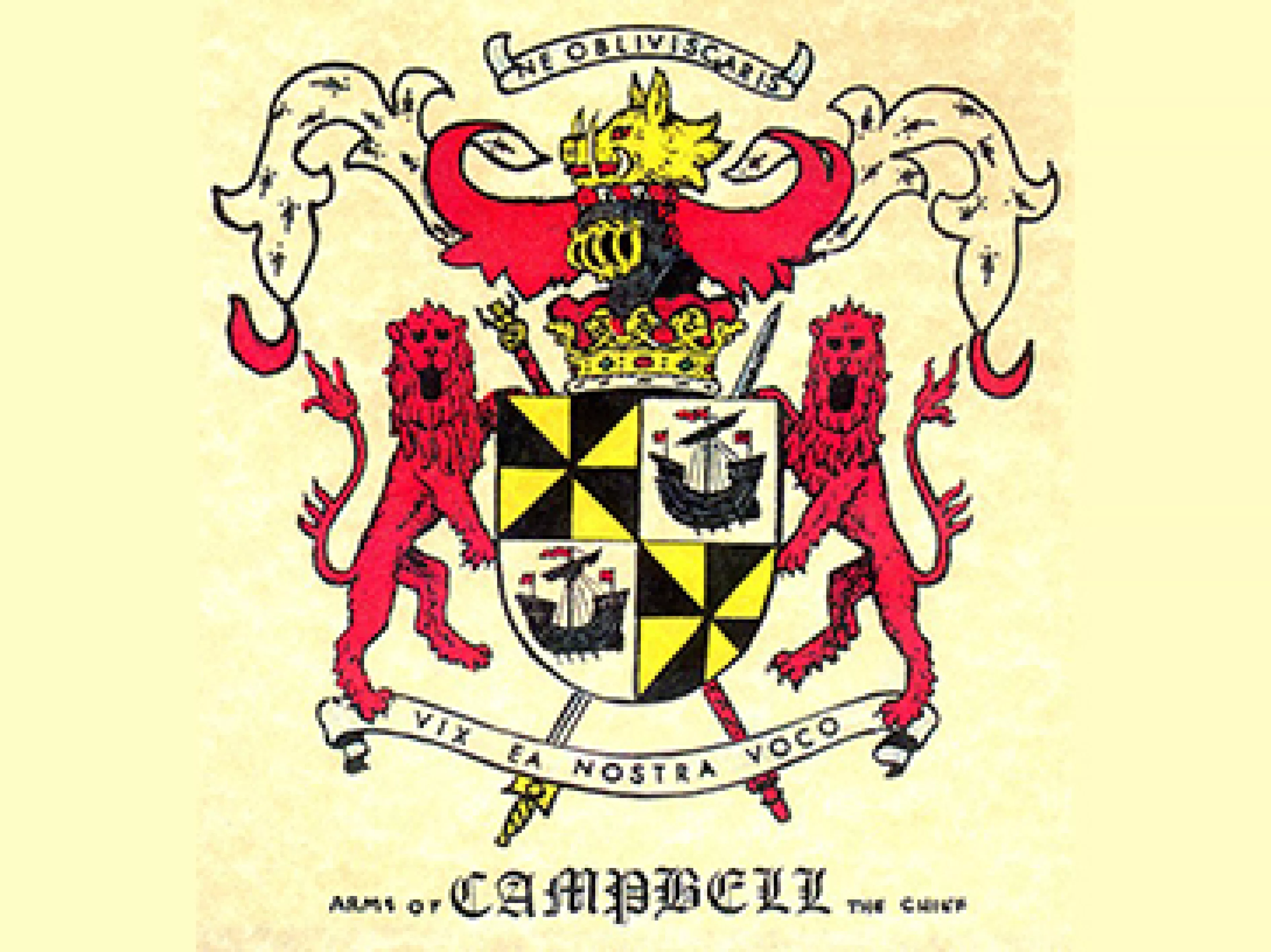Ian Douglas Campbell, 11th Duke of Argyll (S), 4th Duke of Argyll (UK) (1903-1973)
Ian Douglas Campbell, 11th Duke of Argyll (S), 4th Duke of Argyll (UK), was the eldest son of Douglas Walter Campbell, the eldest son of Lord Walter Campbell, third son of the George Campbell, 8th Duke of Argyll, and his wife Aimee Marie Suzanne Lawrence. He was a great-grandson of the 8th Duke of Argyll, and 1st cousin once removed of Niall Diarmid Campbell, 10th Duke of Argyll.
11th Duke of Argyll (S),
4th Duke of Argyll (UK)
Ian Douglas Campbell was born in Paris, France. He was educated at Milton, Massachusetts, U.S.A. and at Christ Church, Oxford University, Oxford, Oxfordshire, England. Ian Campbell fought in the Second World War, attaining the rank of captain in the 8th Battalion Argyll and Sutherland Highlanders. Capt. Campbell was captured in 1940, along with the surviving members of the 51st (Highland) Division, following a rear-guard action at Saint-Valery-en-Caux in Normandy, France and was held as a prisoner of war until 1945.
His five years of mental and physical abuse in Nazis captivity during World War II likely resulted in what is now known as PTSD (Post-Traumatic Stress Disorder) thereby adversely affecting his personality, marriages, family, and personal relationships for the remainder of his life. Not only was there no treatment for PTSD during the Duke's lifetime, PTSD wasn't even recognized as a condition until 7 years after his death in 1980. He was known to be addicted to drink, gambling and prescription drugs, and was described as physically violent and emotionally cruel by his wives. All clinical symptoms of PTSD using the Brief Symptom Inventory (BSI). Scores on PTSD scales are significantly higher in POWs. Those years in a P.O.W. camp broke his health and he suffered from a number of ailments until his death.
Following his liberation from the POW camp in 1945, Capt. Campbell inherited the dukedom from his 1st cousin once removed, the 10th Duke of Argyll in August 1949 along with death taxes totaling more £500,000. The equivalent amount is £18,826,164.99 or $25,518,847.82 USD in Jan. 2022. An enormous sum of money in post WW II depression Britain. According to UK government figures in 1950 the average full-time weekly wage was £7.08. Thus, the 11th Duke of Argyll had to pay the equivalent of 70,621.46 weeks, or 1358.11 years of average wages in Death Taxes on the Argyll Estate. This, at a time when only a few dozen people in the UK could be barely counted as "millionaires". The new Duke was forced to sell off 28,857 acres of the finest farming land in Kintyre, which had been in Campbell hands since the early 1600s, to pay the debt.
Less than a year later, in 1950, part of Inveraray Castle was destroyed by fire and had to be rebuilt. This was not the first time fire devastated the castle, nor would it be the last. The first being in 1877 and the next in 1975. Following the 1950 fire and restoration of the damage, the castle was opened to tourists in 1953 for the first time ever.
No sooner did the 11th Duke of Argyll take possession of Inveraray Castle from his late cousin than he planned to dredge Tobermory Bay and raise the Spanish galleon which tradition held was sunk there.
Tobermory Bay by Glan Williams
In 1588, after the defeat of the Spanish Armada, the 'Create Treasure Shippe of Spaine', called the Duque di Florencia, sailed northwards to the friendly Scottish coast, hoping for refuge. Although England and Spain were at war, the Scots were still well-disposed towards Spain, which was then the richest country in the world. But Elizabeth's highly efficient secret service discovered the Spaniards' intent, and wrecked the ship on 11 September 1588, by having a spy set fire to the powder room. Spanish propaganda subsequently claimed that it was only a small hired transport, but Elizabeth's informers knew otherwise. The ship was said to contain "30 million worth of treasure".
It rested on the silt at the bottom of Tobermory Bay, and has since resisted all attempts to recover it. Charles I gave up trying, and granted salvage rights to the 1st Duke of Argyll, who was thereby permitted to keep whatever booty the wreck might contain, with the sole condition that the royal coffers might receive one per cent of the treasure's value. The present Duke of Argyll still retains this unique right. On nine occasions between 1661 and 1919 attempts had been made, and small pieces had been brought to the surface - candlesticks, doubloons, swords, compasses. By 1954 the Duke had established that the Tobermory Bay galleon was no legend; it was the only known galleon of the Spanish Armada, and it was still there. The ship and it's treasure remains undiscovered and unrecovered as of 2022.
In 1951 the Duke's second marriage also ended in divorce, and Argyll married an old friend, Margaret Whigham Sweeney a few months later in 1951. She devoted herself to the task of restoring Inveraray Castle with a passion for which the local inhabitants are still grateful. It was largely as the result of her work that the little town of Inveraray, a model of town planning, was recognized as worthy of protection as a national monument. In August 1959 the marriage erupted into a public quarrel which bounced in and out of the courts for the next four years. The Duke was granted his divorce, and married for a fourth time not long afterwards. In 1969 the Duke went to live in France, where he had spent much of his youth (he was bilingual). He returned to Scotland, an ill man, in 1973, and died in hospital.
Married: (1) 12 Dec 1927 (div 1934) Hon Janet Gladys Aitken in Halifax, Nova Scotia, Canada (married: (2) 5 Mar 1935 Hon William Drogo Sturges Montagu, 2nd son by his first wife of George Charles Montagu, 9th Earl of Sandwich; married: (3) 11 Jul 1942 Maj Thomas Edward Dealtry Kidd MBE; d. 1988), only dau. of William Maxwell Aitken, 1st Baron Beaverbrook, by his wife Gladys Henderson Drury, 2nd dau. of Maj Gen Charles William Drury CB, of Halifax, Nova Scotia, Canada. Died: 18 Nov. 1988
Only child by first wife:
1. Lady Jeanne Louise Campbell (b. 10 Dec 1928; d. 2007), married: (1) 1962 (div. 1963) as his third wife Norman Mailer, the American novelist (b. 31 Jan 1923; d. 10 Nov 2007), son of Isaac Barnett Mailer, and (2) 2 Mar 1964 John Sergeant Cram, of Hopewell House, Irish Town, Jamaica, son of Henry Sergeant Cram, of Foot Point Plantation, Bluffton, USA, and had issue by both husbands. Lady Jeanne Campbell was brought up mainly by her father when her mother returned to Canada without her. Died: 4 Jun 2007
Married: (2) 23 Nov 1935 (div 1951) Louise Hollingsworth Morris Clews Vanneck (former wife of Hon Andrew Nicholas Armstrong Vanneck MC; d. 10 Feb 1970), only dau. of Henry Clews, of Chateau La Napoule, Alpes Maritime, France.
Louise Hollingsworth Morris Clews, formerly Vanneck; (November 27, 1904 – February 10, 1970) was the second wife of then Capt. Ian Douglas Campbell, later 11th Duke of Argyll and the mother of the 12th Duke of Argyll. She was the daughter of the American-born artist and sculptor Henry Clews Jr. (1876–1937), and his first wife, the New York socialite Louise Hollingsworth (née Morris) Gebhard (1877–1936). Before her parents' 1901 marriage, her mother had been married to Frederick Gebhard. Her paternal grandparents were Henry Clews, an English-born Wall Street investment banker, and Lucy Madison (née Worthington) Clews, who was related to U.S. President James Madison. Her maternal grandparents were John Boucher Morris and Louise Kittera (née Van Dyke) Morris.
Two years after her divorce from Vanneck, she married 32-year-old Captain Ian Douglas Campbell, later 11th Duke of Argyll, on November 23, 1935. During the Second World War, while Capt. Campbell was a prisoner of war Louise escaped Nazi occupied Paris and crossed the Pyrenees to Lisbon, where she helped with relief efforts. Among other things, she arranged for beer and Christmas puddings to be received at the POW camps. Capt. Ian Campbell inherited his cousin's dukedom in 1949, making Louise the Duchess of Argyll. The duke was a notorious spendthrift, and, when asked, Louise is said to have replied, "He took everything but my trust funds." The duchess filed for divorce because of the duke's adultery with the woman who would become his third wife, the notorious Margaret Whigham Sweeny. During her marriage, Louise Hollingsworth Morris Clews was styled as Duchess of Argyll on 20 August 1949 until her divorce in 1951. She was referred to as the "Former Duchess" until her death.
She relocated to the United States following her divorce, and her third marriage was to Robert Clermont Livingston Timpson (1908–1988), an American investment banker, in 1954. Timpson was the grandson of John Henry Livingston of the prominent Livingston family. They moved into Grasmere, a mansion in Rhinebeck, which she later opened to the public.
Louise divorced her third husband in 1963, and the former duchess died in New York at the age of 65. Died: February 10, 1970.
Children by second wife:
1. Lord Ian Campbell, later Marquess of Lorne, later 12th Duke of Argyll, b. 28 Aug 1937, married Iona Mary Colquhoun dau. of Sir Ivar Iain Colquhoun of Luss, 8th Bt. and Kathleen Nimmo Duncan d. 21 Apr 2001. Had issue.
Through her eldest son, she was the grandmother of Torquhil Ian Campbell, 13th Duke of Argyll (born 1968), who married Eleanor Cadbury, a member of the Cadbury chocolate family, they have three children, and Lady Louise Iona Campbell (born 1972), who married Anthony Merrik Burrell and they have two children.
2. Lord Colin Ivar Campbell (b. 14 May 1946), married: 23 Mar 1974 (div. 1975) Georgia Ariana Ziadie, dau. of Michael Ziadie, of Jamaica. Without issue.
Married: (3) 22 Mar 1951 (div 1963) Margaret Whigham Sweeney (former wife of Charles Sweeny; d. 1993), only dau. of George Hay Whigham, of London. Mrs. Sweeny, a wealthy English beauty who had been celebrated in a lyric of Cole Porter's “You're the Top.” The Duke sued for divorce on the grounds of adultery by his wife, with the divorce a sensational and sordid affair. A pair of photographs were in court showing the Duchess, naked save for three strings of pearls, in a sexual act with a unknown man. Their marriage ended in divorce in 1963 in a court case that attracted worldwide attention. The Duke obtained divorce on the ground of his wife's misconduct with four men after the longest and costliest divorce action in Scottish legal history. Due to the involvement of a high ranking UK government official, the divorce nearly brought down the British Government. Without issue.
(Side note: Duchess Margaret's daughter from her first marriage, Frances Helen Sweeny (b. 1937) married Charles John Robert Manners, 10th Duke of Rutland on 15 May 1958, together they had 4 children, and she is the mother of David Charles Robert Manners, 11th Duke of Rutland. She is still alive as of January 2022 and following her husband's death in 1999, she has been known as Frances Manners, The Dowager Duchess of Rutland.)
Married: (4) 15 Jun 1963 Mathilda Coster Heller (former wife of Prof Clemens Heller, of Paris; d. 6 Jun 1997), dau. of Stanley Mortimer, of Lichfield, Connecticut. Died: 6 June 1997
Only child by fourth wife:
2. Lady Elspeth Campbell (b. 29 Apr 1967; d. 4 May 1967)
Born: 18 Jun 1903
Died: 7 Apr 1973
Tenure: 20 Aug 1949 - 7 Apr 1973 (23 years, 7 months, 19 days)
Titles and Honors: He succeeded as the Chief of the Honorable Clan Campbell, Mac Cailein Mór on 20 August 1949.
He succeeded as the 21st Lord Campbell [S., 1445] on 20 August 1949.
He succeeded as the 20th Earl of Argyll [S., 1457] on 20 August 1949.
He succeeded as the 20th Lord Lorne [S., 1470] on 20 August 1949.
He succeeded as the 14th Lord of Kintyre [S., 1626] on 20 August 1949.
He succeeded as the 13th Baronet Campbell, of Lundy in Angus, co. Forfar [N.S., 1627] on 20 August 1949.
He succeeded as the 11th Duke of Argyll [S., 1701] on 20 August 1949.
He succeeded as the 11th Marquess of Kintyre and Lorn [S., 1701] on 20 August 1949.
He succeeded as the 11th Earl of Campbell and Cowall [S., 1701] on 20 August 1949.
He succeeded as the 11th Viscount of Lochow and Glenyla [S., 1701] on 20 August 1949.
He succeeded as the 11th Lord of Inverary, Mull, Morvern and Tirie [S., 1701] on 20 August 1949.
He succeeded as the 7th Baron Sundridge, of Coomb Bank, Kent [G.B., 1766] on 20 August 1949.
He succeeded as the 8th Baron Hamilton of Hameldon, co. Leicester [G.B., 1776] on 20 August 1949.
He succeeded as the 4th Duke of Argyll [U.K., 1892] on 20 August 1949.
He held the office of Keeper of the Great Seal [Scotland] on 20 August 1949.
He held the office of Keeper of Dunstaffnage, Carrick, Tarbert and Dunoon Castles on 20 August 1949.
He held the office of Hereditary Grand Master of the Royal Household [Scotland] on 20 August 1949.
He held the office of Admiral of the Western Coasts and the Isles on 20 August 1949.
He was appointed Knight, Most Venerable Order of the Hospital of St. John of Jerusalem (K.St.J.)
He was awarded the Territorial Decoration (T.D.) in 1953.
Preceded by: 1st cousin once removed Niall Diarmid Campbell, 10th Duke of Argyll (S), 3rd Duke of Argyll (UK)
Succeeded by: eldest son by second wife Ian Campbell, 12th Duke of Argyll (S), 5th Duke of Arygll (UK)
Burial: Loch Awe Inishail Old Parish Churchyard, Inishail, Argyll and Bute, Scotland
